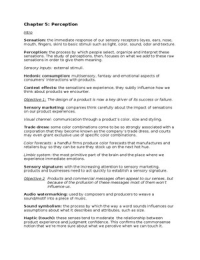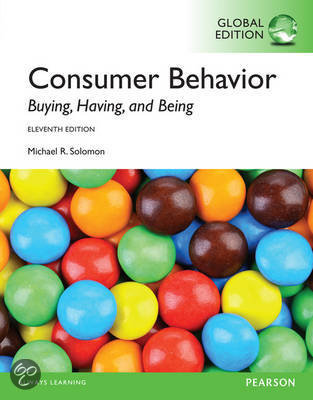Chapter 5: Perception
Intro
Sensation: the immediate response of our sensory receptors (eyes, ears, nose,
mouth, fingers, skin) to basic stimuli such as light, color, sound, odor and texture.
Perception: the process by which people select, organize and interpret these
sensations. The study of perceptions, then, focuses on what we add to these raw
sensations in order to give them meaning.
Sensory inputs: external stimuli.
Hedonic consumption: multisensory, fantasy and emotional aspects of
consumers’ interactions with products.
Context effects: the sensations we experience, they subtly influence how we
think about products we encounter.
Objective 1: The design of a product is now a key driver of its success or failure.
Sensory marketing: companies think carefully about the impact of sensations
on our product experiences.
Visual channel: communication through a product’s color, size and styling.
Trade dress: some color combinations come to be so strongly associated with a
corporation that they become known as the company’s trade dress, and courts
may even grant exclusive use of specific color combinations.
Color forecasts: a handful firms produce color forecasts that manufactures and
retailers buy so they can be sure they stock up on the next hot hue.
Limbic system: the most primitive part of the brain and the place where we
experience immediate emotions.
Sensory signature: with the increasing attention to sensory marketing,
products and businesses need to act quickly to establish a sensory signature.
Objective 2 Products and commercial messages often appeal to our senses, but
because of the profusion of these messages most of them won’t
influence us.
Audio watermarking: used by composers and producers to weave a
sound/motif into a piece of music.
Sound symbolism: the process by which the way a word sounds influences our
assumptions about what it describes and attributes, such as size.
Haptic (touch): these senses tend to moderate the relationship between
product experience and judgment confidence. This confirms the commonsense
notion that we’re more sure about what we perceive when we can touch it.
, Kinsei engineering: a philosophy that translates customer’s feelings into
design elements. E.g., the designers of the Mazda Miata focused on young drivers
who saw the car as an extension of their body, a sensation they call “horse and
rider as one”. After extensive research they discovered that making the stick shift
exactly 9.5 centimeters long conveys the optimal feeling of sportiness and
control.
Objective 3 Perception is a three-stage process that translates raw stimuli into
meaning.
The process of perception: this process is made up by exposure, attention and
interpretation.
Exposure: occurs when a stimulus comes within the range of someone’s sensory
receptors. Consumers concentrate on some stimuli, are unaware of others and
even go out of their way to ignore some messages.
Sensory threshold: the capability of perceiving stimuli. Stimuli may be above or
below a person’s sensory threshold (= zingtuigelijke drempel), or the point at
which it is strong enough to make a conscious impact in his or her awareness.
Psychophysics: the science that focuses on how people integrate the physical
environment into their personal, subjective worlds.
Absolute threshold: the minimum amount of stimulation a person can detect
on a given sensory channel. E.g., the sound a dog whistle emits is at too high
frequency for human ears to pick up.
Differential threshold: the ability of a sensory system to detect changes in or
differences between two stimuli.
- j.n.d. (just noticeable difference): the minimum difference we can detect
between two stimuli.
Weber’s Law: the stronger the initial stimulus, the greater a change must be for
us to notice it.
Objective 4 Subliminal advertising is a controversial – but largely ineffective –
way to talk to consumers.
Subliminal: stimuli that fall below the limen (threshold).
Subliminal perception: a stimulus below the level of the consumer’s
awareness.





